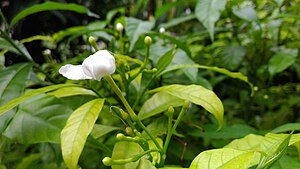Note: This is a project under development. The articles on this wiki are just being initiated and broadly incomplete. You can Help creating new pages.
Difference between revisions of "Tabernaemontana divaricata - Nandyavarta"
(→Photo Gallery) |
(→External Links) |
||
| Line 85: | Line 85: | ||
[[Category:Ayurvedic herbs that don't have flower, fruit and leaf photos]] | [[Category:Ayurvedic herbs that don't have flower, fruit and leaf photos]] | ||
[[Category:Ayurvedic herbs that don't have seed photos]] | [[Category:Ayurvedic herbs that don't have seed photos]] | ||
| + | [[Category:Apocynaceae]] | ||
Revision as of 12:44, 27 May 2019
Tabernaemontana divaricata is a plant is placed in front of the home is the sign of wealth. Five petals having Nandyavarta is having special medicinal features. It is also used for worshiping god.
Contents
- 1 Uses
- 2 Parts Used
- 3 Chemical Composition
- 4 Common names
- 5 Properties
- 6 Habit
- 7 Identification
- 8 List of Ayurvedic medicine in which the herb is used
- 9 Where to get the saplings
- 10 Mode of Propagation
- 11 How to plant/cultivate
- 12 Commonly seen growing in areas
- 13 Photo Gallery
- 14 References
- 15 External Links
Uses
Wounds, Cuts, Snakebites, Liver disorders, Skin eruptions, Blotches, Pimples, Diarrhea, Sore throats
Parts Used
Chemical Composition
Voafinidine (C20H28N2O2) and voalenine in minor amounts and a new 2-acylindole alkaloid, ervaticine. Coronaridine, voacristine, tabernaemontanine, dregamine; α-amyrin, lupeol, β-sitosterol, voacangine and voaphylline have also been isolated from leaves[1]
Common names
| Language | Common name |
|---|---|
| Kannada | |
| Hindi | |
| Malayalam | |
| Tamil | |
| Telugu | |
| Marathi | NA |
| Gujarathi | NA |
| Punjabi | NA |
| Kashmiri | NA |
| Sanskrit | |
| English | Crape jasmine |
Properties
Reference: Dravya - Substance, Rasa - Taste, Guna - Qualities, Veerya - Potency, Vipaka - Post-digesion effect, Karma - Pharmacological activity, Prabhava - Therepeutics.
Dravya
Rasa
Tikta (Bitter), Kashaya (Astringent)
Guna
Laghu (Light), Ruksha (Dry), Tikshna (Sharp)
Veerya
Ushna (Hot)
Vipaka
Katu (Pungent)
Karma
Kapha, Vata
Prabhava
Habit
Identification
Leaf
| Kind | Shape | Feature |
|---|---|---|
| Simple | opposite | The leaves are oval, 8 to 15 cm (3 to 6 in) long, dark glossy green, prominently veined and have a leathery texture |
Flower
| Type | Size | Color and composition | Stamen | More information |
|---|---|---|---|---|
| Unisexual | 4 cm | Yellow | 5 | The flowers are trumpet-shaped, about 4 cm (1.6 in ) across, with five waxy white petals in a pin-wheel arrangement. |
Fruit
| Type | Size | Mass | Appearance | Seeds | More information |
|---|---|---|---|---|---|
| General | 7 cm | The fruit are rare but when produced are curved, ribbed | six | {{{6}}} |
Other features
List of Ayurvedic medicine in which the herb is used
- Vishatinduka Taila as root juice extract
Where to get the saplings
Mode of Propagation
How to plant/cultivate
A plant of tropical and subtropical areas, growing at low to medium elevations. Succeeds in full sun to partial shade Prefers a fertile, moist but well-drained soil[3]
Commonly seen growing in areas
Mountain areas, Sparse forest areas.
Photo Gallery
References
External Links
- Ayurvedic Herbs known to be helpful to treat Wounds
- Ayurvedic Herbs known to be helpful to treat Cuts
- Ayurvedic Herbs known to be helpful to treat Snakebites
- Ayurvedic Herbs known to be helpful to treat Liver disorders
- Ayurvedic Herbs known to be helpful to treat Skin eruptions
- Ayurvedic Herbs known to be helpful to treat Blotches
- Ayurvedic Herbs known to be helpful to treat Pimples
- Ayurvedic Herbs known to be helpful to treat Diarrhea
- Ayurvedic Herbs known to be helpful to treat Sore throats
- Herbs with Dried folaige used in medicine
- Herbs with Whole herb used in medicine
- Herbs with common name in English
- Habit - Evergreen shrub
- Index of Plants which can be propagated by Seeds
- Index of Plants which can be propagated by Cuttings
- Herbs that are commonly seen in the region of Mountain areas
- Herbs that are commonly seen in the region of Sparse forest areas
- Herbs
- Ayurvedic herbs that don't have flower, fruit and leaf photos
- Ayurvedic herbs that don't have seed photos
- Apocynaceae



